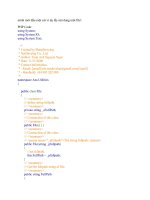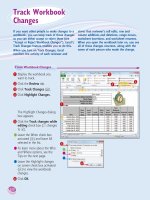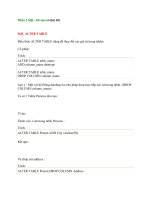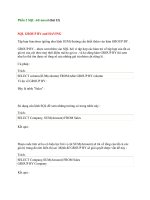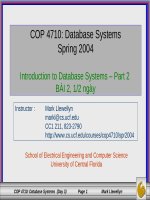Tài liệu Database Systems - Part 13 pdf
Bạn đang xem bản rút gọn của tài liệu. Xem và tải ngay bản đầy đủ của tài liệu tại đây (746.91 KB, 52 trang )
COP 4710: Database Systems (Day 17) Page 1 Mark Llewellyn
COP 4710: Database Systems
Spring 2004
Introduction to SQL
BÀI 13, 2 ngày
COP 4710: Database Systems
Spring 2004
Introduction to SQL
BÀI 13, 2 ngày
School of Electrical Engineering and Computer Science
University of Central Florida
Instructor : Mark Llewellyn
CC1 211, 823-2790
/>COP 4710: Database Systems (Day 17) Page 2 Mark Llewellyn
History of SQL
•
SQL, pronounced “S-Q-L” by some and “sequel” by others (mostly
old-timers), has become the de facto standard language for creating
and querying relational databases.
•
It has been accepted by ANSI (American National Standards
Institute) and ISO (International Standards Organization) as well as
being a FIPS (Federal Information Processing Standard).
•
Between 1974 and 1979, workers at the IBM Research Laboratory
in San Jose, California undertook the development of System R.
This was shortly after Codd’s classic paper defining the relational
database was published. The goal of the System R project was to
demonstrate the feasibility of implementing the relational model in
a DBMS. They used a language named SEQUEL (Structured
English QUEry Language), which was a descendent of SQUARE
(Specifying QUeries As Relational Expressions), both of which
were developed at IBM, San Jose.
•
SEQUEL was renamed to SQL during this project.
COP 4710: Database Systems (Day 17) Page 3 Mark Llewellyn
History of SQL (cont.)
•
System R itself was never produced commercially, but directly led
to the development of SQL/DS (1981 running under DOS/VE OS, a
VM version followed in 1982) which was IBM’s first commercial
relational DBMS.
•
IBM however, did not produce the first commercial implementation
of a relational DBMS. That honor went to Oracle (Relational
Software) in 1979.
•
Today, the relational DBMS system of virtually all vendors is based
on SQL.
•
Each vendor provides all the standard features of SQL. Most
vendors also provide additional features of their own, called
extensions to standard SQL. These extensions lead to portability
issues when moving SQL-based applications across various
RDBMS. Vendors attempt to distinguish their SQL versions
through these extensions.
COP 4710: Database Systems (Day 17) Page 4 Mark Llewellyn
History of SQL (cont.)
•
The current version of ANSI standard for SQL is SQL-
99 (also referred to as SQL3). This standard has also
been accepted by ISO.
•
Although many different extensions of SQL exist, we’ll
look at the core SQL that will be found on any RDBMS
that you will encounter. Whether you use Oracle,
Microsoft SQL Server, IBM’s DB2, Microsoft Access,
MySQL, or any other well-established RDBMS, you’ll
be able to get up to speed on that system with the
information in this set of notes.
COP 4710: Database Systems (Day 17) Page 5 Mark Llewellyn
SQL
•
SQL is a complete relational database language in the sense
that it contains both a data definition language (DDL) and a
data manipulation language (DML).
•
We’ll examine components of both parts of SQL.
•
If you use Microsoft Access, for example, you’ll need to
know less about the DDL side of SQL than you will if you
use Oracle 9i or MySQL.
•
The table on the following pages summarize the commands in
the DDL portion of SQL. The entries in the table do not
correspond to the order in which you will use the commands,
but simply give a quick summary of those available. The
table does not contain a complete listing of the commands in
the DDL portion of SQL.
COP 4710: Database Systems (Day 17) Page 6 Mark Llewellyn
Summary of SQL DDL Commands
Command or Option Description
CREATE SCHEMA AUTHORIZATION
Creates a database schema
CREATE TABLE
Creates a new table in the user’s DB schema
NOT NULL
Constraint that ensures a column will not have null values
UNIQUE
Constraint that ensures a column will not have duplicate values
PRIMARY KEY
Defines a primary key for a table
FOREIGN KEY
Defines a foreign key for a table
DEFAULT
Defines a default value for a column (when no value is given)
CHECK
Constraint used to validate data in a column
CREATE INDEX
Creates an index for a table
CREATE VIEW
Creates a dynamic subset of rows/columns from 1 or more tables
ALTER TABLE
Modifies a table’s definition: adds/deletes/updates attributes or
constraints
DROP TABLE
Permanently deletes a table (and thus its data) from the DB
schema
DROP INDEX
Permanently deletes an index
DROP VIEW
Permanently deletes a view
COP 4710: Database Systems (Day 17) Page 7 Mark Llewellyn
The DDL Component Of SQL
•
Before you can use a RDMS two tasks must be completed: (1)
create the database structure, and (2) create the tables that will hold
the end-user data.
•
Completion of the first task involves the construction of the
physical files that hold the database. The RDBMS will
automatically create the data dictionary tables and create a default
database administrator (DBA).
–
Creating the physical files requires interaction between the host OS and
the RDBMS. Therefore, creating the database structure is the one
feature that tends to differ substantially from one RDBMS to another.
•
With the exception of the creation of the database, most RDBMS
vendors use SQL that deviates very little from ANSI standard SQL.
Nevertheless, you might occasionally encounter minor syntactic
differences. For example, most RDBMSs require that any SQL
command be ended with a semicolon. However, some SQL
implementations do not use a semicolon. I’ll try to point out most
of the common syntactic differences, or at least the ones of which I
am aware.
COP 4710: Database Systems (Day 17) Page 8 Mark Llewellyn
Use Of DDL Commands In SQL
•
We’ll use the database shown on the next page for illustrating the
DDL commands of SQL. This database is a bit more involved than
our supplier-parts-jobs-shipments database, but its along the same
lines. The business rules that apply to this database are:
1. A customer may generate many invoices. Each invoice is generated by
one customer.
2. An invoice contains one or more invoice lines. Each invoice line is
associated with one invoice.
3. Each invoice line references one product. A product may be found in
many invoice lines. You can sell more than one hammer to more than
one customer.
4. A vendor may supply many products. Some vendors may not supply
any products,
5. If a product is vendor-supplied, that product is supplied by only one
vendor.
6. Some products are not supplied by a vendor, they may be made “in-
house” or obtained through other means.
COP 4710: Database Systems (Day 17) Page 9 Mark Llewellyn
An Example Database
COP 4710: Database Systems (Day 17) Page 10 Mark Llewellyn
SQL Syntax Notation
Notation Description
CAPITALS
Required SQL command keyword
italics
An end-user provided parameter – normally required
{a | b | }
A mandatory parameter, use one from option list
[ ]
An optional parameter – everything in brackets is optional
tablename
The name of a table
column
The name of an attribute in a table
data type
A valid data type definition
constraint
A valid constraint definition
condition
A valid conditional expression – evaluates to true or false
columnlist
One or more column names or expressions separated by commas
tablelist
One or more table names separated by commas
conditionlist
One or more conditional expressions separated by logical operators
expression
A simple value (e.g., 76 or ‘married’) or a formula (e.g., price-10)
COP 4710: Database Systems (Day 17) Page 11 Mark Llewellyn
Creating Table Structures Using SQL
•
The CREATE TABLE syntax is:
CREATE TABLE tablename (
column1 data type [constraint] [,
column2 data type [constraint] ] [,
PRIMARY KEY (column1 [,column2] )] [,
FOREIGN KEY (column1 [,column2] ) REFERENCES tablename ] [,
CONSTRAINT constraint ] ) ;
COP 4710: Database Systems (Day 17) Page 12 Mark Llewellyn
Example – Table Creation
•
As an example, let’s create the VENDOR table as
described on page 11.
CREATE TABLE VENDOR (
V_CODE INTEGER NOT NULL UNIQUE,
V_NAME VARCHAR(35) NOT NULL,
V_CONTACT VARCHAR(15) NOT NULL,
V_AREACODE CHAR(3) NOT NULL,
V_PHONE CHAR(8) NOT NULL,
V_STATE CHAR(2) NOT NULL,
V_ORDER CHAR(1) NOT NULL,
PRIMARY KEY ( V_CODE));
COP 4710: Database Systems (Day 17) Page 13 Mark Llewellyn
The VENDOR Table in Access(-)
COP 4710: Database Systems (Day 17) Page 14 Mark Llewellyn
Example – Table Creation
•
Now let’s create the PRODUCT table as described on page 11.
CREATE TABLE PRODUCT (
P_CODE VARCHAR(10) NOT NULL UNIQUE,
P_DESCRIPT VARCHAR(35) NOT NULL,
P_INDATE DATE NOT NULL,
P_ONHAND SMALLINT NOT NULL,
P_MIN SMALLINT NOT NULL,
P_PRICE NUMBER(8,2) NOT NULL,
P_DISCOUNT NUMBER(4,2) NOT NULL,
V_CODE INTEGER,
PRIMARY KEY ( P_CODE),
FOREIGN KEY (V_CODE) REFERENCES VENDOR ON UPDATE CASCADE);
COP 4710: Database Systems (Day 17) Page 15 Mark Llewellyn
The PRODUCT Table in Access(-)
COP 4710: Database Systems (Day 17) Page 16 Mark Llewellyn
Example – Table Creation
•
Now let’s create the CUSTOMER table as described on page 11.
CREATE TABLE CUSTOMER (
CUS_CODE NUMBER PRIMARY KEY,
CUS_LNAME VARCHAR(15) NOT NULL,
CUS_FNAME VARCHAR(15) NOT NULL,
CUS_INITIAL CHAR(1),
CUS_AREACODE CHAR(3) DEFAULT ‘615’ NOT NULL
CHECK (CUS_AREACODE IN (‘615’, ‘713’, ‘931’)),
CUS_PHONE CHAR(8) NOT NULL,
CUS_BALANCE NUMBER(9,2) DEFAULT 0.00,
CONSTRAINT CUS_UI1 UNIQUE (CUS_LNAME, CUS_FNAME));
Creates a unique index constraint named CUS_UI1
on the customer’s last name and first name.
Table
constraint
Column
constraint
COP 4710: Database Systems (Day 17) Page 17 Mark Llewellyn
The CUSTOMER Table in Access(-)
COP 4710: Database Systems (Day 17) Page 18 Mark Llewellyn
Example – Table Creation
•
Now let’s create the INVOICE table as described on page 11.
CREATE TABLE INVOICE (
INV_NUMBER NUMBER PRIMARY KEY,
CUS_CODE NUMBER NOT NULL, REFERENCES CUSTOMER(CUS_CODE)
INV_DATE DATE DEFAULT SYSDATE NOT NULL,
CONSTRAINT INV_CK1 CHECK (INV_DATE > TO_DATE(’01-JAN-2002’, ‘DD-MON-YYYY’)));
Check constraint is used to validate that the invoice
date is greater than January 1, 2002. The TO_DATE
function requires two parameters, the literal date and
the date format used.
Alternative way to define a
foreign key
Special function that
returns today’s date
COP 4710: Database Systems (Day 17) Page 19 Mark Llewellyn
The INVOICE Table in Access(-)
COP 4710: Database Systems (Day 17) Page 20 Mark Llewellyn
Example – Table Creation
•
As a final example of table creation, let’s create the LINE table as
described on page 11.
CREATE TABLE LINE (
INV_NUMBER NUMBER NOT NULL,
LINE_NUMBER NUMBER(2,0) NOT NULL,
P_CODE VARCHAR(10) NOT NULL,
LINE_UNITS NUMBER(9,2) DEFAULT 0.00 NOT NULL,
LINE_PRICE NUMBER(9,2) DEFAULT 0.00 NOT NULL,
PRIMARY KEY (INV_NUMBER, LINE_NUMBER),
FOREIGN KEY (INV_NUMBER) REFERENCES INVOICE ON DELETE CASCADE
FOREIGN KEY (P_CODE) REFERENCES PRODUCT(P_CODE),
CONSTRAINT LINE_UI1 UNIQUE(INV_NUMBER, P_CODE));
Table constraint prevents the
duplication of an invoice line.
The use of ON
DELETE CASCADE is
recommended for weak
entities to ensure that
the deletion of a row in
the strong entity
automatically triggers
the deletion of the
corresponding rows in
the dependent weak
entity.
COP 4710: Database Systems (Day 17) Page 21 Mark Llewellyn
The LINE Table in Access(-)
COP 4710: Database Systems (Day 17) Page 22 Mark Llewellyn
Some Notes On Table Creation
•
Given our sample database, the PRODUCT table contains a foreign
key that references the VENDOR table. Thus, the VENDOR table
must be created first. In general, the table on the “1” side of a 1:M
relationship must be created before the table on the “M” side can be
created.
•
In Oracle 9i, if you use the PRIMARY KEY designation you do not
specify the NOT NULL and UNIQUE specifications. In fact, you
will get an error message if you do so.
•
ON UPDATE CASCADE is part of the ANSI standard but several
RDBMSs do not support it. Oracle is one which does not support
this specification.
•
If the primary key is a composite key, all of the attributes of the key
are contained within a set of parentheses and are separated by
commas. For example, the table LINE on page 11 would have its
primary key defined as:
PRIMARY KEY (inv_number, line_number).
COP 4710: Database Systems (Day 17) Page 23 Mark Llewellyn
Some Notes On Table Creation (cont.)
•
Support for referential constraints varies widely from
RDBMS to RDBMS.
–
MS Access, SQL Server, and Oracle support ON DELETE
CASCADE.
–
MS Access and SQL Server, support ON UPDATE CASCADE.
–
Oracle does not support ON UPDATE CASCADE.
–
Oracle supports SET NULL.
–
MS Access and SQL Server do not support SET NULL.
•
MS Access does not support ON DELETE CASCADE
or ON UPDATE CASCADE at the SQL line level,
however, it does support it through the relationship
window interface (see Day 16 notes).
COP 4710: Database Systems (Day 17) Page 24 Mark Llewellyn
The DML Portion of SQL
•
The DML portion of SQL can be viewed as two separate
components which overlap in certain areas. The two
components are the non-query DML commands and the
query DML commands.
•
Non-query DML commands allow you to populate tables
(INSERT), modify data in tables (UPDATE), delete data
from tables (DELETE) as well as make changes
permanent (COMMIT) and undo changes (to some
extent with ROLLBACK).
•
The query DML commands essentially consist of a
single statement (SELECT) with many different optional
clauses.
•
We’ll look at the non-query part of the DML first.
COP 4710: Database Systems (Day 17) Page 25 Mark Llewellyn
Summary of SQL DML Commands
Command or Option Description
INSERT
Inserts row(s) into a table
SELECT
Selects attributes from rows in one or more tables or views
WHERE
Restricts the selection of rows based on a conditional expression
GROUP BY
Groups the selected rows based on one or more attributes
HAVING
Restricts the selection of grouped rows based on a condition
ORDER BY
Orders the selected rows
UPDATE
Modifies attribute values in one or more of a table’s rows
DELETE
Deletes one or more rows from a table
COMMIT
Permanently saves data changes
ROLLBACK
Restores data to their original values
Comparison Operators
=, <, >, <=, >=, <>
Used in conditional expressions
Logical Operators
AND, OR, NOT
Used in conditional expressions

